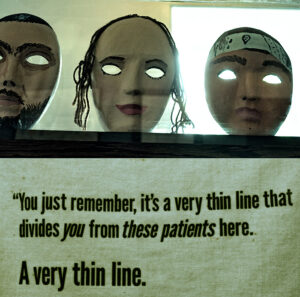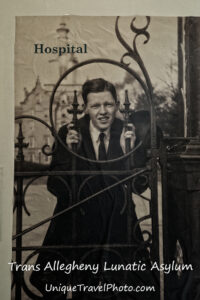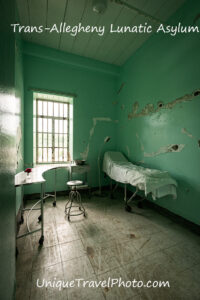.jpg)
Creepy? Evil? Haunted? You decide.
Trans-Allegheny Lunatic Asylum: Kirkbride Building
The Gothic Revival styled Trans-Allegheny Lunatic Asylum, now a national historic landmark, was built in 1864 as a light-filled sanctuary to help heal the mentally ill. This architectural design allowed up to 250 patients to enjoy curative sunshine and fresh air in private rooms staggered along wings spreading 242,000 sq feet across four floors on 666 acres.
The asylum produced its own food with dairy cows, heifers, pigs, corn, and soybeans on a 532 acre farm. And even produced its own heat by operating a small coal mine on the grounds.
Kirkbride
Dr. Thomas Kirkbride, a physician and superintendent of the Pennsylvania Hospital for the Insane (1840-1883), served as founding member and president of the AMSAII, forerunner of the American Psychiatric Association. He believed that the mentally ill could be cured if treated promptly in a country setting away from the place that caused their distress.
He also believed that buildings themselves could “promote healing of lunacy.” His architectural design, a staggered V-shaped floorplan with Victorian interiors, became a standardized model for over 300 asylums built in America during the 19th century, including this one.
.jpg)
Pre-Asylum Era
Kirkbride buildings were a stark contrast to the living conditions of the previous century, where naked individuals lived as animals in cages, filthy almshouses, or unheated jail cells.
Barbaric treatment of insane individuals continued until one particular day, when Sunday school teacher Dorthea Dix visited a jail in 1841. There she witnessed the appalling conditions and treatment of the mentally ill as criminals— chained, neglected and tortured.
After visiting hundreds of jails across America, she exposed the deplorable conditions and lobbied for social reform in America and abroad. She was the greatest advocate in improving their living conditions and restoring their dignity. Thanks to her efforts, government-sponsored asylums were built in the US, Canada and Europe in the 1840’s and provided comfort, therapy and humane care.
Dorthea Dix and Dr. Kirkbride developed a close friendship and worked together, pursuing shared goals. Ironically, when she became ill in her 80’s, Dorthea chose to live out her remaining years at the Trenton State Hospital asylum that she helped establish– that was also the first Kirkbride building.
The Kirkbride Plan
The Trans-Allegheny Lunatic Asylum followed Dr. Kirkbride’s treatment plan, which meant providing care with dignity, stability, discipline and routine. He also believed “that the insane should not be deprived of any comfort, or even luxury.”
.jpg)
A doctor’s living quarters in the Trans-Allegheny Lunatic Asylum
The living quarters inside the Trans-Allegheny Lunatic Asylum were tastefully decorated for staff and patients alike. Doctors and nurses resided in lavish apartments onsite. Patients who were the most mildly afflicated lived in rooms on a wing that resembed an upscale hotel.
.jpg)
Standard rooms had curtains, side tables, artwork. And lots of natural light streaming through tall windows.
.jpg)
Males, who lived in separate wings than females, had carpeted sitting rooms with tables for playing cards, games or conversation. Even males on the adolescent ward dined in style. Rowdy boys learned proper etiquette sitting at linen tables set with fine china.
Until it became too dangerous. In fits of rage, violent teens turned meal time into opportunity. Breaking china or glass, they used sharp shards to stab staff. Or one another.
Kirkbride’s intent was good.
Trans-Allegheny Lunatic Asylum: Curative Rest Therapy
In the late 1800’s, curative rest therapy became all the rage for treating mental illness. For women.
Dr. Silas Mitchell is credited for prescribing these rest regimes. Lasting several months, he confined women to their rooms for total rest and seclusion, without any stimulation. No reading, writing, studying, working or exercising allowed! He believed that total rest could cure ‘nervous’ women afflicted with depression, anxiety, insomnia, migraines or hysteria.
Yet, his recommendation for treating men with the same affliction—was the complete opposite. No rest for them! Instead, he sent them out West on grand adventures that included horseback riding, herding cattle, hunting and bonding with other men. And encouraged them to write about it! Patients that received this “West Cure” included Walt Whitman (who wrote “Specimen Days” about his journey), future President Theodore Roosevelt and novelist Owen Wister (wrote “The Virginian” about his WY adventures).
.jpg)
Female patients could no longer go outdoors for physical exercise or gardening. They were restricted to their rooms. With absolutely nothing to do…except stare at the wall…
.jpg)
Who wouldn’t go mad???
When I saw this mannequin, and all the rooms with peeling wallpaper, I couldn’t help but think of a short story I used to teach my high school English students— “The Yellow Wallpaper“ by Charlotte Perkins Gilman.
Familiar with it?

In the story, the central character experiences post-partum depression after childbirth. Her husband, a doctor, decides her treatment: curative rest for 3 months. He confines her to a room with yellow wallpaper in a country cottage they’ve rented for the summer. She’s not allowed to write (which is her passion), or do anything. Just. Rest. Written in her voice, we witness her progression into psychosis as she ‘sees’ the wallpaper come alive. The more she stares, the more she sees. Yellow patterns begin to swirl, move, separate. She catches glimpses of something …trapped…crawling frantically inside …
I won’t give away the ending.
This story was written in 1892, when women were viewed as hysterical beings who just needed rest. The author herself suffered postpartum depression in 1885 and was prescribed this very rest cure. When her story was published 7 years later, she sent a copy to her doctor.
Guess who? Yep. Dr. Mitchell. The same doctor who told her to “never touch a pen, brush or pencil again.” She let him know that the lack of intellectual stimulation actually worsened her depression and that was detrimental to her health.
.jpg)
Self-expression mask created in art therapy.
Admitting Process
In the later 1800’s, it was true that patients could be admitted to an insane asylum by anyone, including family members. Granted, the general belief was that the person was experiencing temporary psychosis that could be cured…
But look at the mind-blowing reasons why someone could be committed, just on your word:
.jpg) Political excitement. Novel reading. Religious enthusiasm. Seduction. Jealousy. Female disease. Bad company. Snake bite. Dog bite. Falling off a horse. Loss of arm. Indigestion. Greediness. Laziness. And the list goes on.
Political excitement. Novel reading. Religious enthusiasm. Seduction. Jealousy. Female disease. Bad company. Snake bite. Dog bite. Falling off a horse. Loss of arm. Indigestion. Greediness. Laziness. And the list goes on.
Hey, parents— have a troubled teen? Drop ’em off. Men—irritated with your wife? Admit her!
And, as extra incentive, anyone who brought in a patient was given cash. Cash?!
Trans-Allegheny Lunatic Asylum: In the 1900’s
But in the 1900’s, people could no longer drop off boring spouses or bothersome children without a valid reason. Doctors, more than family members, admitted patients for mental illness, depression, suicidal ideations, dementia, mania, or violent behavior.
Many people were still committed against their will. And locked in for LIFE.
.jpg)
The number of mental patients increased significantly after the Great Depression. Jails began emptying their inmates into asylums that became state hospitals. Kirkbride’s Plan to provide moral treatment fell by the wayside as the majority of newly admitted patients were chronic long-term mentally ill patients who couldn’t work on-site (farming, laundry, cleaning) or benefit from therapeutic rehabilitation.
Asylums in the early 1900’s transitioned into nothing more than buildings to provide custodial care to incurable patients.
Tensions mounted with overcrowding. And understaffing.
.jpg)
In 1927, staff included only 3 doctors for the 1300 patients here. Attendants split into teams of 3 per 65 patients, supervising them from 5:45am to 10pm per shift. With so many patients to control, attendants resorted to using stronger punishments for unacceptable behaviors. Restraints, straitjackets, bed straps, and cribs (the size of coffins) confined the unruly.
.jpg)
By the 50’s, admissions swelled to 2,400 patients crammed into spaces designed for 1200. And kept growing. Beds lined the hallways. The asylum had become a dumping ground for unwanted people—without sufficient staff. In 1948, the asylum did adopt a decreased 8 hour work day, but low salaries didn’t match what male attendants could make at defense plants or regular hospitals.
During this time most patients received electroshock therapy 3x a week. The convulsions caused cognitive impairments in memory, attention, and reasoning, plus headaches, fatigue, bone fractures and even permanent brain damage. Many begged to stop. But doctors believed they had the power to overrule patient desires and forced electroshock on unwilling patients to keep them passive.
The physical health, mental health, and general well-being of these patients deteriorated rapidly. As did the building.
Deteriorating Conditions
An article in the Charleston Gazette, Jan 1949, highlighted the poor living conditions at the asylum, then called Weston State Hospital. The reporter, Armentrout, described the gut-wrenching stench, filth and caved-in ceiling in one three-story building, condemned 5 years prior, that still housed male patients supervised by one attendant. In another ward, female patients rocked in chairs or paced barefoot up and down unsanitary halls. Other patients sat confined in restraints. But at least the 7 new wards (rebuilt after a fire) and the dairy barn were clean.
Armentrout’s article joined forces with other articles, books and even a movie, Snake Pit, exposing the current conditions of state hospitals as deplorable custodial institutions that deviated far from the lunatic asylums created to cure mental illness.
Not just here, but all across the country.
Wanting to bring some sense of joy to the unfortunate residents, local volunteers in the little town of Weston organized dances, band concerts, cake walks and basketball competitions at the Trans-Allegheny Lunatic Asylum. The large expansive front yard held Easter egg hunts and even football games. A Recreation department offered art and crafts, and took patients on outings and field trips to state parks.
Despite the poor conditions and salary, many of the employees developed bonds with the residents and provided loving care. (Read stories and recollections about patients from former employees who worked here in the 1950’s: Kim Jack’s WV Univ thesis.)
Due to a nationwide trend of deinstitutionalization in the 1970’s, the number of patients decreased from 2,300 to 1,000. Some patients, on heavy sedatives or antipsychotic drugs, returned home or entered nursing homes. Others transferred to group homes or were discharged into the community with outpatient services. The only patients admitted during the last 20 years were those evaluated by a doctor who deemed them a danger to themselves or others.
This state hospital, and many like it, closed permanently in 1994. The remaining patients transferred to a new facility, the Sharpe Hospital on the backside of the farm.
Trans-Allegheny Lunatic Asylum: Medical procedures
Beginning in the 1930’s, doctors treated patients with sedatives and also experimented with new medical procedures: lobotomy, shock therapy, and hydrotherapy.
Shock therapy used electric currents to induce brain seizures in the hope that convulsions could shake mental illness out of the body. Or shock one’s depression away.
Hydrotherapy locked patients in an icy cold or dangerously hot tub of water for extended time. This treatment attempted to control excitable patients by submerging them in water from the neck down for ten hours up to a few days. Alternatively, Needle Showers pummeled a patient with 50 degree pressurized water for 1-2 minutes to alleviate depression.
Lobotomies aimed to take manic behavior, defiance and anxiety away. Patients fell unconscious from electroshock before doctors stuck an ice pick through their eyes and scrambled their brains.
Dr. Walter Freeman and Dr. James Watt performed the first surgery in the US in 1936. Dr. Freeman performed over 770 transorbital lobotomies between the Trans-Allegheny Lunatic Asylum (known as the Weston State Hospital then) and 4 other West Virginia state hospitals with “a definite benefit to one-third of the patients with no ill effects.”
Freeman, ever the evangelist, drove around in his customized ‘lobotomobile’ van performing lobotomies in front of crowds and at other hospitals. He falsely proclaimed a 80% success rate and denied any detrimental effects in his 1950 book, Psychosurgery. Yet 25% of his patients became incontinent, emotionless and blank-minded—functioning as a “domestic invalid or household pet.” Some went blind, became paralyzed or died.
Even those he considered a success—meaning they could return to work, and lead a fairly normal life without being disruptive—could no longer multi-task or plan ahead as their cognitive executive functions were forever impaired.
His most famous client was Rosemary Kennedy, sister of president John F. Kennedy. Her father, US Ambassador Joseph Kennedy, was embarrased by young Rosemary’s rebellion, attitude and promiscuity and arranged for a lobotomy— without her mother’s knowledge or consent.
Rosemary became a simpleton who couldn’t articulate her words, control bodily functions or show emotion. She stared into space for hours and lived the remainder of her life in institutions. Her parents never visited her, and kept her siblings in the dark about her disappearance. When Rosemary’s father suffered a stroke 20 years later, ironically taking away his speech, the siblings were told the truth. All but JFK visited her regularly until her death at age 86. Her sister, Eunice, founded the Special Olympics in Rosemary’s honor.
.jpg)
This abhorrant practice was generally terminated worldwide in 1956, when critics cited violation of human life. Antipsychotic drugs, like Thorazine, replaced lobotomies. Yet Dr. Freeman continued his surgeries —until he was banned in 1967, when his paying audience witnessed a female patient die from a brain hemorrhage during a live lobotomy.
(Apparently a few countries still perform lobotomies to treat epilepsy, OCD and depression.)
In the mid-1960’s, pharmaceutical companies marketed Thorazine as a cure for schizophrenia if taken continuously. But the Parkinson-like side effects caused stiff gait (walking) and mask-like facial features, rapid heartbeat, slowed thinking, restlessness or lethargy, jerky movements, tics and blurred vision.
Antipsychotic drugs replaced shock therapy too, becoming the only treatment between the 1960’s and 1990’s.
Insanity
According to psychiatrist Albert Deutch, “Someone labeled ‘insane’ may be regarded as just ‘eccentric’ in a different community.”
Who hasn’t experienced depression, insomnia, anxiety?

Many residents at Trans-Allegheny Lunatic Asylum suffered less characteristics of mental illness than people living life outside those stone walls.
Common disorders that landed them here in the 1950’s included bipolar, schizophrenia, depression, dementia, mental retardation, alcohol or drug addiction.
Some only stayed a short time to overcome a stressful experience, a mild head injury or grief. And many recovered, but chose not to leave. The Medical Center housed these private paying rehab-to-home patients in a nicer separate building of 109 beds staffed with 2 nurses, 2 doctors and aides.
Trans-Allegheny Lunatic Asylum: Criminally Insane Forensic Building
A new Forensic building completed in the early 1950’s housed the most dangerous patients. Courts ordered criminals, claiming the insane card, to the Trans-Allegheny Lunatic Asylum until their judgement day.
.jpg)
The Forensic building kept criminals separate from patients in the Kirkbride building, so they wouldn’t contaminate the mentally ill. (Ironically, the most violent patients were actually teenaged males inside the Kirkbride building who killed the most staff and residents.)
.jpg)
Visiting lawyers stood in this protected space to counsel their clients.
.jpg)
Unlike the Kirkbridge building, the Forensic building housed all the men in one large room, dormitory style. There were also 5 solitary cells.
.jpg)
A long line of barred windows in this building provided lots of light, but no insulation from the cold. And nothing to dampen the high level of noise–which reached deafening levels.
.jpg)
Although security was high, and the building supposedly foolproof, many criminals escaped.
.jpg)
Our guide told us gruesome stories about convicted criminals who lived here and murdered people in the surrounding communities. She knew some of the victims first-hand, lending a very personal perspective to the tour.
.jpg)
Trans-Allegheny Lunatic Asylum Today
After sitting vacant for many years, Morgantown businessman Joe Jordan purchased it at auction for $1.5M in 2007. He and his children began renovations and opened it for tours the following year.
They’ve collected artifacts, antiquated medical equipment, newspaper articles, nursing uniforms and assembled informational displays on the main floor of the Kirkbridge building. Their intent is to educate, remove stigmas, and to open conversations about mental healthcare.
Tours
Walk through shadowy halls, listening to stories about the people who lived here…
.jpg) Four buildings on the property are open for tours: Kirkbride (main hospital building where most tours go), Medical, Geriatric & Forensic. The Women’s Auxillary building is off limits except for the photography tour.
Four buildings on the property are open for tours: Kirkbride (main hospital building where most tours go), Medical, Geriatric & Forensic. The Women’s Auxillary building is off limits except for the photography tour.
Also allow time (45 minutes) to walk through the exhibits on the first floor before or after your tour.
Tours operate April-Nov, 12-6pm; daily except Mondays:
Paranormal Tours (90 min, guided, leave every 2 hours)
Historic Tours (45/90 min, leave on the hour)
Flashlight Tours (30 min, half historic/paranormal)
Criminally Insane Tour (1 hour, Forensic building)
VIP Tour (90 min, Wed & Sat, Kirkbride 2-3 floors)
Photography Tours (4 hours, am or pm, 3 buildings, select dates)
Discoverer Tour (5 hours; covers ALL 4 buildings, Mondays in 2023)
Ghost Hunts (8 hours, overnight, guided or wander alone)
Check out their Calendar for special events. October features all things spooky…haunted house, flashlight tours, ghost hunts, paranormal tours, an asylum ball, zombie paintball ride and more.
.jpg)
Trans-Allegheny Lunatic Asylum Location
Weston, West Virginia is 3 miles west of I-79, in the northwestern part of the state. Driving distance is 2 hours south of Pittsburgh, Pennsylvania, 4.5 hours northeast of Lexington or 5 hours west of Washington DC.
Weston is small with a population under 4,000 people. Yet there’s plenty of lodging in familiar chain hotels, or the wonderful Stonewell Jackson resort 11 miles south that has an indoor/outdoor pool, hiking trails, golf course, recreational lake and fire pit for s’mores. Our family stayed there 2 nights enroute to Pennsylvania back in May. We had a full day to take 2 tours at the asylum (VIP and Criminally Insane) and poke around town. Recommend breakfast with locals at the Heaters and dinner at Thyme Bistro.
~~~~~~~~~~~~~~~~~~~~~~~~~~~~~~~~~~~~~~~~~~~~~~~~~~~~~~~~~~~~~~~~~~~~~
Save a pic on your Pinterest board for later!



2 comments
I love the fact that I could have the chance to see it that would be so cool.
Yes! So thankful for all those who sacrifice love and money to preserve a slice of history!